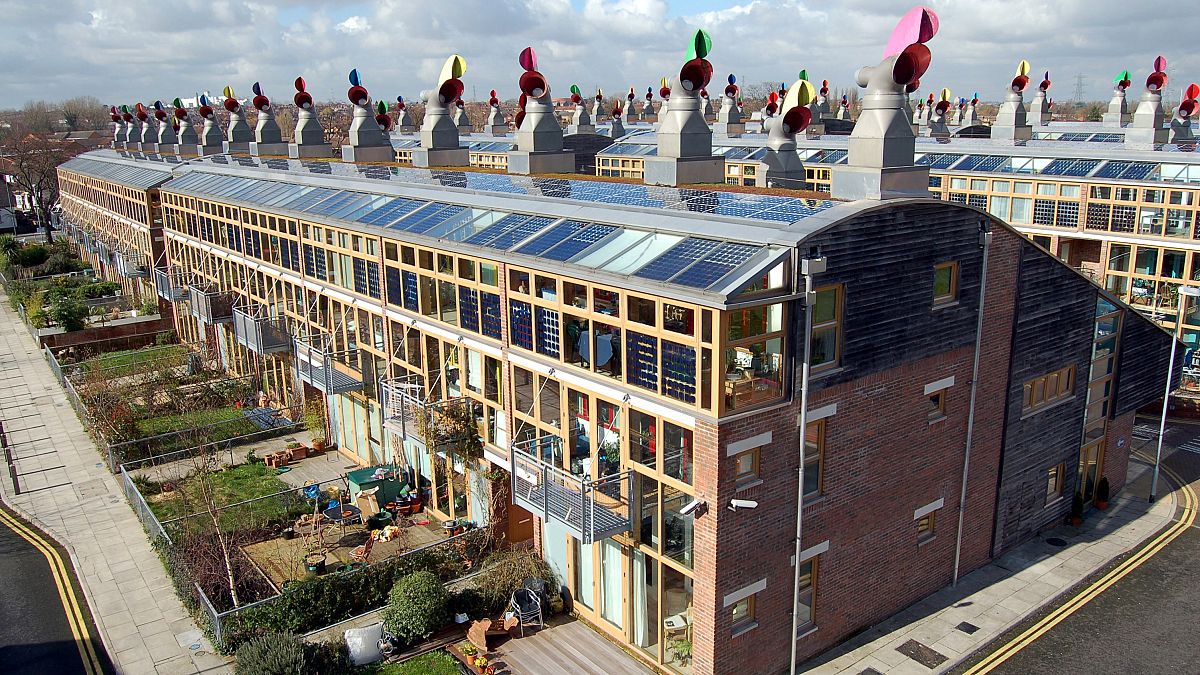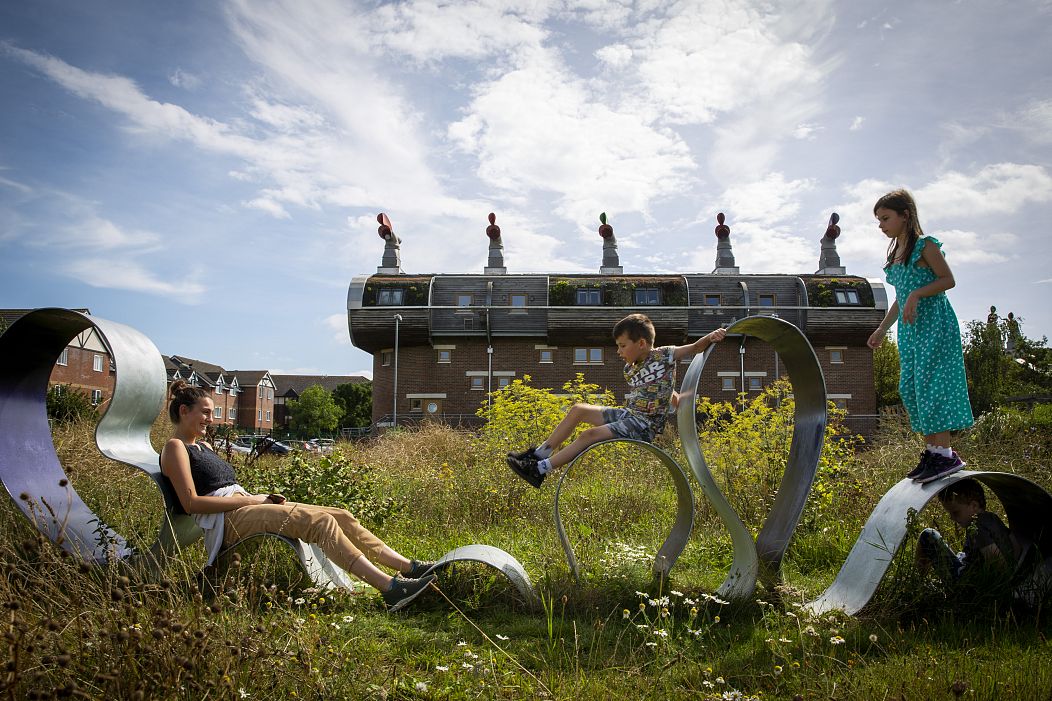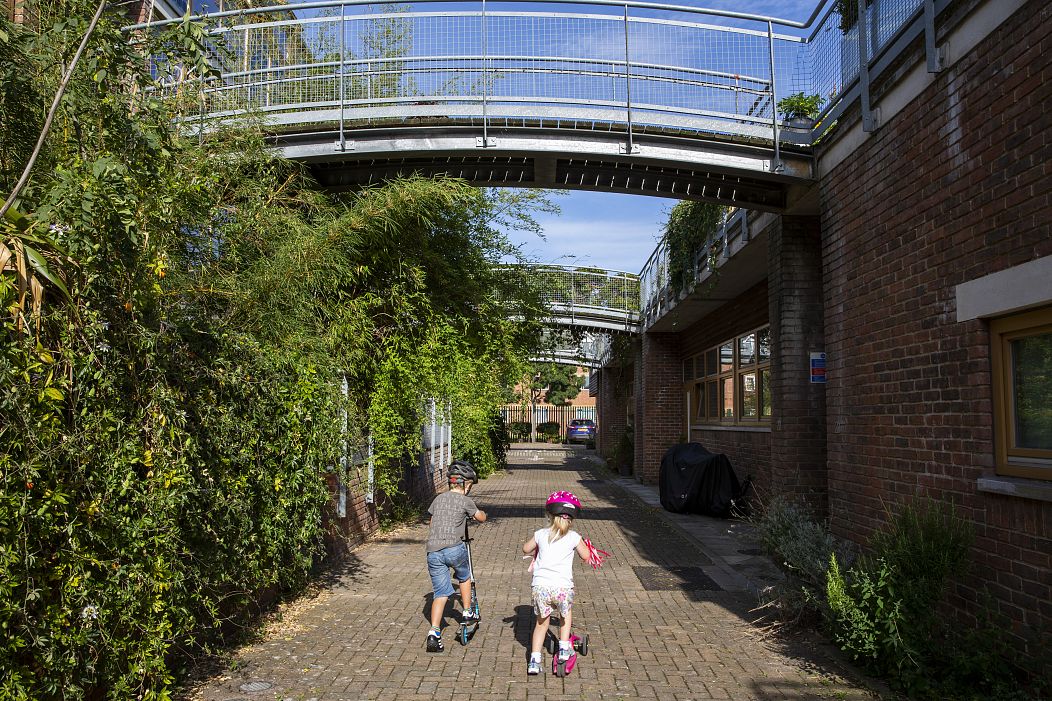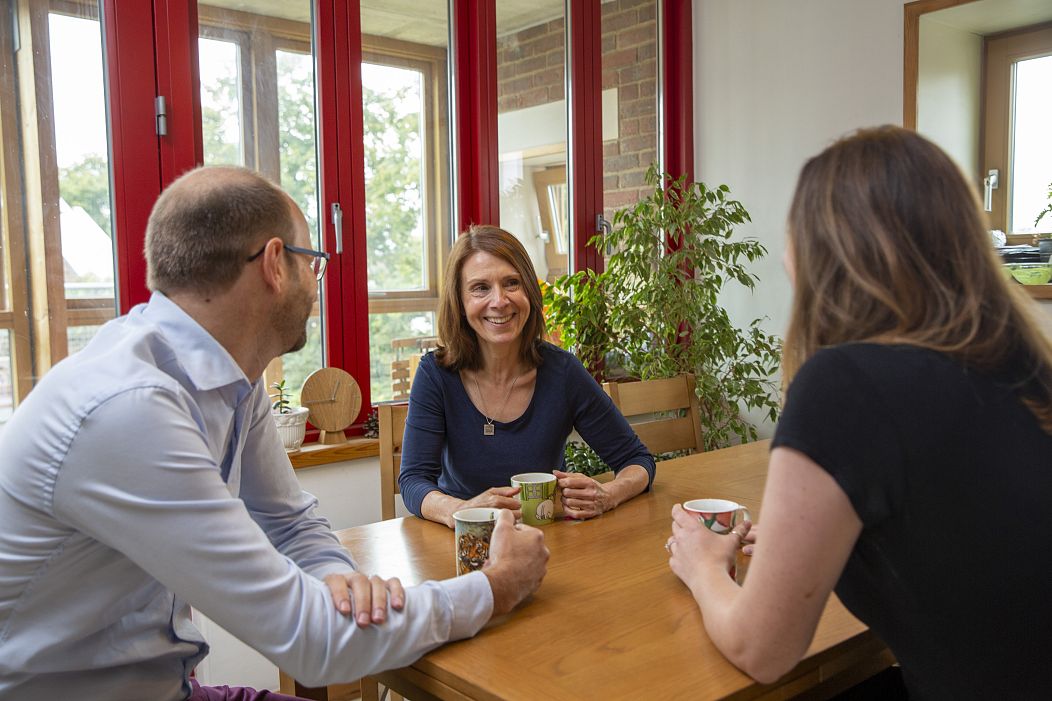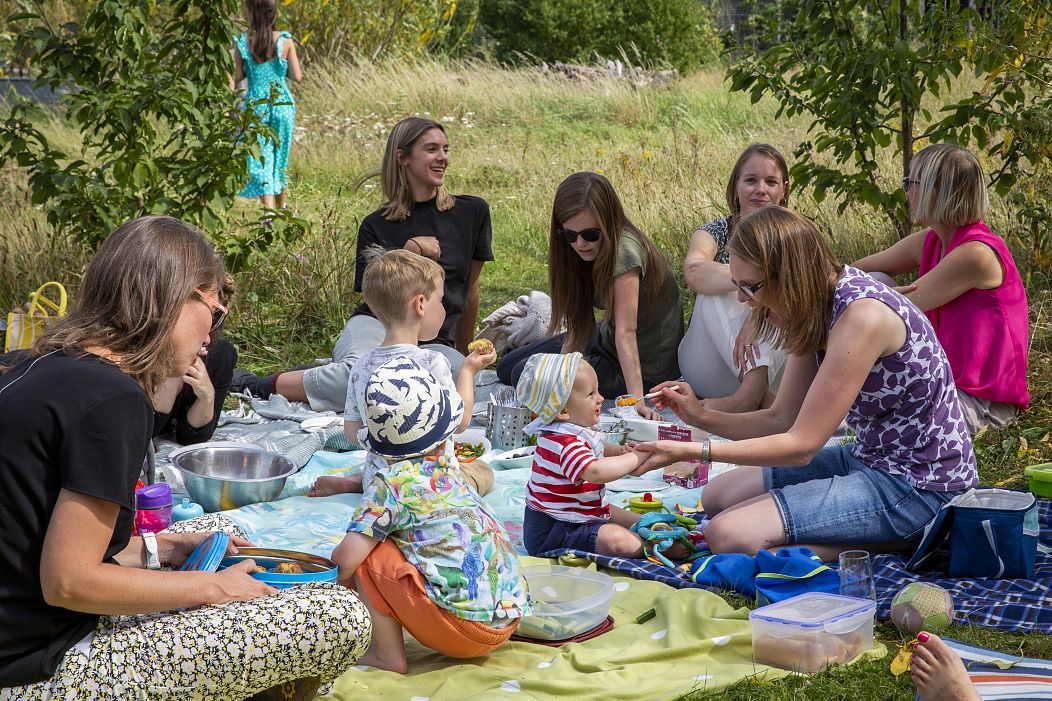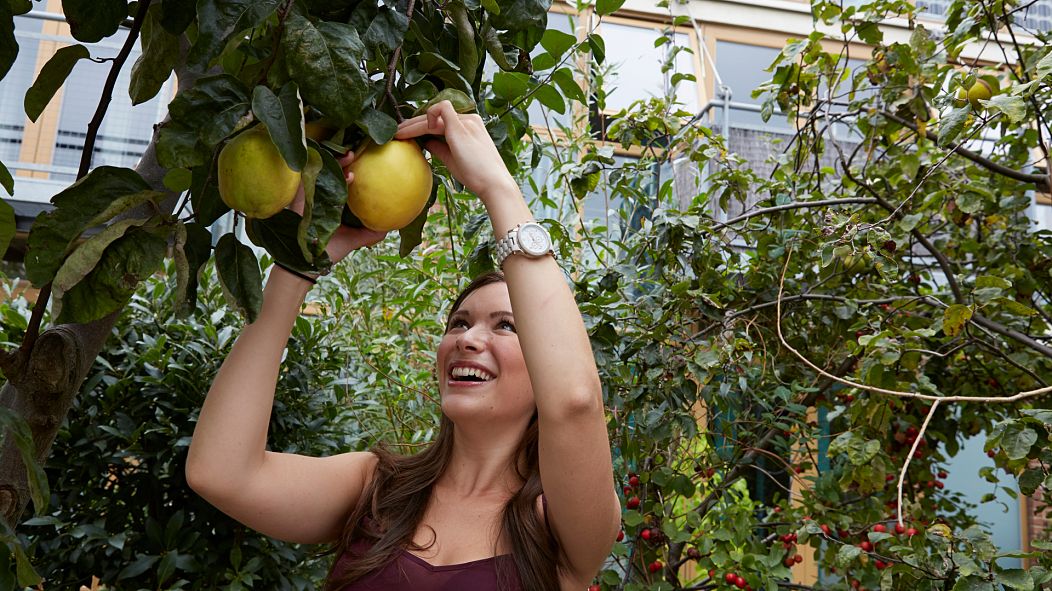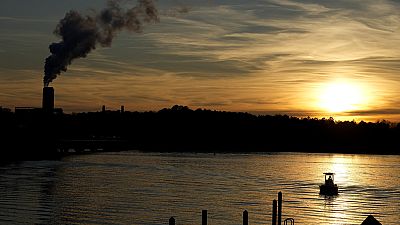The 250-strong village produces no carbon on a daily basis, with residents living entirely sustainably.
Hackbridge is a modest pocket of suburbia in southwest London. Pulling into the railway station on a brisk morning, I survey the industrial surroundings and don’t feel an immediate urge to explore. It’s safe to say, I had imagined a leafier greeting upon visiting the UK’s first eco village.
It might not be prettiest London borough, but after a short walk of about ten minutes, I finally get a glimpse of the eco-haven I am expecting. BedZED (Beddington Zero Energy Development) lies just off the main road, surrounded by green, and comprises a unique community of zero-carbon-emitting dwellers.
Upon arrival, my eye is first drawn to what look like multi-coloured chimneys on top of the array of glass buildings - these in fact are wind cowls. The cowls act as wind-driven natural ventilation systems, which heat up the homes sustainably. Each home has its own set of solar panels just visible and a small patch of garden, full of flowerbeds and bikes leaning against the fence. Glass walls flood the interiors with natural light, and although this doesn’t provide much privacy, the community is sectioned off from the road so you’re unlikely to have passers-by peeking in.
BedZED eco-village is the real deal - no greenwashing to be seen or heard here. I am shown around by Sue Riddlestone OBE, the founder of social enterprise Bioregional, whose offices are on the premises. This is a company so committed to being green that they host vegan lunch clubs for employees every week and even conduct bin audits to try and reduce as much waste as possible!
I am keen to ask her what exactly a ‘zero carbon’ village really means. Do you simply offset your emissions with carbon balancing schemes like planting trees, I ask? Absolutely not, she says, BedZED doesn’t produce any carbon in the first place, so there would be nothing to offset.
How can a village produce no carbon emissions at all?
Maybe ‘village’ is a bit of a stretch, BedZED currently houses around 250 people, so it’s more of a tight-knit community. 50% of homes are privately owned, a quarter is reserved for social (low cost) rent and the remaining quarter is shared ownership. The properties vary from one-bedroom apartments to four-bedroom town houses and measure anywhere from 37 m2 to 131m2 .
“They’re not all eco-warriors though,” Jessica Rowley who works at Bioregional, tells me honestly. “Some have come to live here as they are incredibly environmentally aware, but others may have been placed here through social housing and have since adapted to the way of life. After a while, zero carbon living just becomes the new norm.”
None of the homes use central heating, something I found particularly impressive. The way it works is, south-facing homes generate heat via conservatories, which trap the sun and in turn warm up the house. The wind cowls also exchange heat from the air and walls have extra thick insulation. The north-facing homes are just as insulated, but they rely on a biomass boiler for heat. This burns sustainably sourced wood chips to generate heat, instead of heating gas or oil. Residents tell me the average inside temperature during winter feels like low 20s (C°) and only occasionally do they use back-up electric heaters.
Given that 80% of CO2 generated by energy in homes is directly from space heating, this is a big achievement for the BedZED development.
There are six recycling sites around village and food composting is heavily encouraged. Homes contain aerated shower heads to save on water use. The idea is simple, but extremely effective – shower heads pump out hot air, while giving you a reduced flow of water. The result is the illusion that you’re having a power shower, when in fact you are conserving water. Homes in the eco-village use 40% less water than other residencies in Sutton.
To top it off, all houses have beautiful sky gardens, residents have their own allotments and there is an eco-school next door for children to attend, a recent expansion of Hackbridge Primary School. Naturally, the added bonus of the school has made homes at the housing development more and more competitive to obtain.
How do residents get to and from the village?
Barely any cars are allowed on site (0.6 per household) to encourage car sharing, cycling and public transport. Bikes are ten a penny and there are three bus routes, as well as the train station, within 10 minutes’ walk.
The first car club in Britain was created here in Hackbridge in 2008. Research shows that, along with the beneficial reduction in car miles, car clubs also break the link between car use and car ownership, which is crucial if we are to drastically decrease emissions in future. European research estimates that car club members reduce their total travel CO2 emissions by 40% to 50%.
Resident David Tchilingirian describes his experience of life at BedZED.
“I've lived here for 15 years, much longer than I would have imagined. The estate was so novel all those years ago in a normal, suburban part of south-west London. We had a family here and our children have loved the freedom to play in the streets and on our field. Families have grown together and there is a bind and a connection - we really help one another.”
For David, it's been a learning curve. "I was not particularly eco when I moved in but I’ve grown to value our environment more. I have learnt the need to reduce, reuse, recycle and protect what is good. I don't miss any luxuries,” he says.
Did the team face any challenges when building the eco-development?
BedZED was built back in 2002 and, as such, had to overcome numerous obstacles in both the planning and building processes. As the model was a prototype, the industry wasn’t used to this kind of building, so construction workers required extra training which was both costly and time consuming. Equally, the timeframe was pushed as sourcing reclaimed materials took much more time than simply purchasing ‘off the shelf’.
Another problem was how to implement a water supply that was fully sustainable. The original plan was to opt for rainwater collection, to be used as ‘grey water’ for waste functions like flushing toilets. However, the team soon realised that harvesting rainwater could be tricky as it was often contaminated, posing a risk to water quality. Nowadays, the houses benefit from a membrane bioreactor (MBR), which is a filter for all water treatment.
Wellness and community spirit are just as important
Environmental sustainability is not the only thing on the eco-village agenda. Wellness and community spirit are equally as important and reflect the BedZED ethos perfectly. A community pavilion lies at the end of the garden where tenants can congregate for classes and workshops and there is an old-fashioned village square in which to gather together.
According to a recent report by think tank IPPC north, community spirit seems to be lacking in the UK of late. The north/south divide is particularly pronounced, as Brits complain the centralised government in Westminster means that the rest of the country is forgotten. “The UK is more regionally divided than any comparable advanced economy," the report says, citing lack of devolution as making the country unequal in areas like health, jobs, disposable income and productivity.
As a result, more than half of Brits barely say a word to their neighbours, according to a new poll. In fact, 68% would describe them as strangers and a whole 84% fail to participate in any local events.
At BedZED, the atmosphere is much friendlier than your typical neighbourhood. Sue tells me that, on average, residents in the UK know around 8 of their neighbours (in London even less), whereas at BedZED, each resident knows around 20 neighbours in total. This increases community cohesion, which in turn means tenants are more likely to work collaboratively to come up with sustainable solutions in the village.
How can we replicate more eco-villages in the rest of the UK?
The question is, can the BedZED model be reproduced in other areas of the UK, or worldwide? Chris Rogers is a Professor of Geotechnical Engineering at the University of Birmingham and specialises in sustainable cities.
For Professor Rogers, eco developments can only come about if the community is willing to work together to sustain it. Building more villages is not just about top-down policy and encouragement from the government, in fact it’s “individual and community attitudes/behaviours” that determine whether they will last.
“In short, the environmental benefits of sustainable developments can only be brought about by the people who live there, and working on such a common cause brings communities together, which in turn encourages good behaviours,” Rogers explains.
“Good practices are infectious, which is why building community spirit is so important,” he concludes.
The team at Bioregional hope their sustainable framework, One Planet Living, can be rolled out all over the country, with housing developers adhering to their ten simple principles. These include putting people first, working holistically and taking into account everything from energy, water and transport, to community, health and happiness in the planning process.
At the end of the day, the point is to make sustainable living “comfortable, easy and crucially – mainstream,” Jessica from Bioregional concludes.
“A green lifestyle doesn’t have to mean making sacrifices.”
